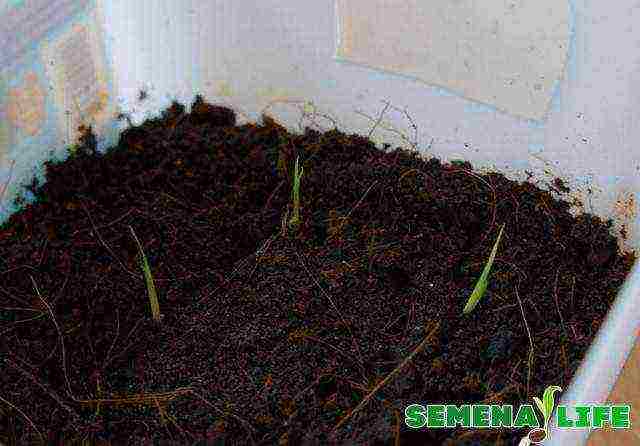Content
How to grow bearded irises on the balcony
 Greetings, friends!
Greetings, friends!
Irises have always attracted attention with their beauty and aroma. Bearded varieties brought from Germany look beautiful both in the garden and in a pot on the balcony. This unpretentious type of irises grows beautifully in any conditions. They can be planted both in spring and in summer, and even in autumn.
When grown by seed, the irises become smaller and less beautiful.
In order to conduct growing irises at home and on the balcony, it is best to purchase a ready-made plant with a developed root system, without damage. The bulb should have the beginnings of new roots. Her color should be uniform, without dark spots. The root part should be green, rich in color and have about 10 leaves.
When the plant is purchased, it needs to be dried a little so that the upper part of the root system is slightly weathered.
To plant irises on the balcony, you need to take a mixture of soil with peat and the addition of phosphorus nitrogen and potassium fertilizers, instead of potash fertilizers, you can take ash, at the rate of 30 grams per plant. The soil can be alkaline or slightly acidic, necessarily light and loose. It is not advisable to add organic fertilizers, otherwise the plant will become thickened and start to hurt.
At the bottom of the container, where the iris will grow, you can pour a layer of shells, pebbles or expanded clay. To prevent moisture stagnation, there must be holes in the container.
In a small hole, a root (bulb) is planted so that the above-root part remains practically free and is watered with settled water.
At first, seedlings can stand in a dark, cool place if flowering is expected in winter. Or it is exhibited right away on the balcony so that it blooms in early autumn.
Also, for better growth, the rhizome should be slightly tilted to the south, so that the upper part of the iris goes north. This allows the plant to grow faster and not get sick.
At the beginning of winter, the irises are exposed to the light so that they bloom by February.
When planting several plants at once, you need to purchase for them  separate pots or a long container that will allow you to plant them spaciously, since irises do not like tightness. The distance should be at least half a meter between them. Low-growing (dwarf) varieties can be planted at a distance of 25 centimeters.
separate pots or a long container that will allow you to plant them spaciously, since irises do not like tightness. The distance should be at least half a meter between them. Low-growing (dwarf) varieties can be planted at a distance of 25 centimeters.
Around the plant, you need to loosen the soil and eliminate weeds as they appear. It is impossible to water the soil too much, since all varieties of bearded irises do not like excess moisture.
Miniature dwarfs, these are early varieties of bearded irises, reaching a height of 20 centimeters and having large beautiful flowers.
The standard dwarf varieties, which grow up to 35 centimeters, bloom after the miniature species.
Medium varieties of bearded irises reach 70 centimeters.
Tall bearded irises are considered more popular.
For growing bearded irises on a glazed balcony in winter, Siberian iris, Aryl, Ideal, Appolo are suitable.
When the plant grows, after two years it can be divided and transplanted.
Can be carried out growing irises at home absolutely any varieties, but you need to take into account that high varieties can grow greatly and take up a lot of space, and miniature and dwarf irises can be planted around the perimeter of the balcony and enjoy their beautiful and fragrant flowers. Read also about diseases and pests of irises. See you!

How to grow irises?
How to grow irises. Irises: home care. Irises: soil. Irises: transplant. Conditions for growing iris.
Iris reticulata
Most plants in the Iris family are too large to grow in pots, but there are a few dwarf irises that are great for home keeping. They all grow from rhizomes, which must be planted in early autumn so that the irises bloom in late winter or early spring.
Plant 6-8 rhizomes in a 12 cm pot or bowl, covering the rhizomes with soil.
Irises do not need to be kept in the dark after planting in pots - a cool, bright place, such as a shaded window sill, will do. When the plants are ready to bloom, transfer the pot to a well-lit area. Be careful not to overfeed dwarf irises, as this will result in many offspring but no flowers.
Varieties of iris: Iris reticulata. Iris danfordiae, Iris bakeriana and Iris histriodes.
Conditions for keeping irises
Illumination: Provide moderate light during growth and full light during flowering. When the plant is blooming, shade it out of direct sunlight.
Temperature: during the growth period, keep the planting at a temperature of 4-7 degrees, during flowering, make sure that the temperature does not exceed 13-16 ° C.
Irises watering: After planting the rhizomes, saturate the potting mix with water, then water the plant once a week to keep the soil moist. Water 2-3 times a week during flowering.
Air humidity: keep the plant cool and dry. Do not spray it.
Irises top dressing: if you plant a rhizome to grow it for subsequent plantings, then every 10 days apply liquid fertilizer for indoor plants, diluted to the manufacturer's recommended concentration. Start feeding when the flower buds form and stop when the leaves are dead.
Soil for irises: clay soil mixture for indoor plants or a special fibrous substrate for bulbous.

Features of iris care
Dwarf irises are easy to care for and thrive in pots or bowls. The stems grow to a height of 10-20 cm and in late winter or spring bloom with purple or blue flowers, often with white specks. After flowering is over, cut off the flowering stems, leaving the foliage behind. Reduce watering gradually. Remove any yellowed leaves, remove the rhizome, separate all suckers, and save the parent rhizome for later planting in a pot or outdoors in early fall. If you have a summer cottage, the offspring of the iris can be planted in the garden, and they will bloom in 2-3 years.
We recommend watching:
Fertilizers for irises
No comments yet. Yours will be the first!
There are two ways of raising cockerels from seed:
- disembarkation in September;
- disembarkation in March.
Freshly harvested seeds are planted in September. This is the easiest way. However, if frosts come late, the sprouts may have time to rise. In this case, they will die.
Better to spend more time but plant the seeds in March. To do this, at the beginning of February, the seeds must be wrapped in a damp cloth, placed in a container with a lid and placed under the freezer. They should be kept at a temperature of 3-5 ° C. The seeds should be stored in this way for 1 month. In March, they need to be planted in a container filled with soil and placed in a warm place. As soon as the sprouts appear, they need to provide additional lighting. It is necessary to transplant sprouts into the ground in May.
Males can be grown at home, however, for this you need to choose only dwarf varieties, since the usual ones will be too tall and voluminous for pots. In order for irises to grow at home, certain conditions must be created for them.
- The soil. Irises work well with fibrous potting soil for bulbous plants, but if you don't have it on hand, you can use regular clay potting potting soil.
- Lighting. Lighting should be moderate during growth and full during flowering. Avoid leaving blooming irises in direct sunlight.
- Temperature. Irises don't like heat. During the flowering period, it is desirable that the temperature is not higher than 16 ° C.
- Watering. Saturate the soil well with water before planting. Subsequently, water the plant once a week.During the flowering period, the frequency of watering should be increased up to 2-3 times a week.
- Top dressing. Introduce liquid plant food 10 days after planting. Then start feeding when the buds form and finish after the yellow leaves are dead.
- Air humidity. Irises love dry air. Spraying is not required for these flowers.
By the way, you can transplant such flowers into open ground at any time. They will continue to grow and bloom.
Try planting different varieties of irises in your home and garden. Outwardly, they are very different in color, shape of petals and even smell. These plants will become a bright decoration of the flower bed.
A perennial plant with a beautiful name iris is in demand among flower growers; it is grown on personal plots, dachas, window sills. Translated from Greek "iris" means rainbow, as the plant has an incredible variety of colors. Another name is also used - "kasatik".
What is the popularity of the plant based on
Iris has many advantages, these include: beauty and grace of the flower, delicate aroma, high decorativeness of the stem, foliage, variety of shapes, shades, unpretentiousness, good winter hardiness.
However, the last two properties are more likely to belong to Siberian irises, accustomed to severe weather conditions.
Types of irises, some of the nuances of their cultivation
A common cultivated species of irises are bearded irises, so named for the soft bristly growths on the lower petals. They are also called "northern orchids".
Siberian irises are graceful, resistant to adverse weather conditions, unpretentious, immune to bacteriosis, and are able to heal soil infected with bacteriosis.
Japanese (xiphoid iris) are distinguished by an unusual flower shape. Plants are picky, require dry wintering (covered with oak leaves, plastic wrap), slightly acidic soil with uniform, medium moisture during the flowering period.
Swamp irises are the most persistent, they grow well near water, in water, on swampy soils, in dry places. The life span of the marsh killer whale is about 8 years. Moreover, it does not require maintenance at all.

How to grow irises from seeds
The flowering period of irises in our country lasts from April to mid-July. This does not mean that one variety will delight you for two and a half months, each of them is given no more than 15 days to bloom. Cunning gardeners place several varieties with different flowering periods on the same lawn, admiring the beautiful flowers until mid-summer.

There are never many irises on the site - the unearthly beauty of this flower can be admired endlessly. It is for this reason that many gardeners choose to grow iris from seeds.
With specific irises, everything is simple - after the end of the flowering period, right on the stem, carefully pack the box with immature seeds in gauze or synthetic tulle. The seeds ripen until autumn, you can not keep track of the cracking of the capsule.

Method number 1
In mid-September, seeds are planted in a garden bed (planting depth - 2 cm, distance between rows and in a row - 10 cm). So that the tender sprouts do not die from frost in autumn and spring, they are covered with a padding polyester, which will serve as an air cushion.
Method number 2
The seeds are stratified - wrapped in a damp cloth, placed in a closed container, kept on the top shelf of the refrigerator for 1 month. February - sowing time, prepare a peat pot for each seed, deepen it by 2 cm. Seedlings need light and warmth.
Seedlings are planted in May.
Both methods are good for breeding specific irises, varietal ones can upset a novice breeder with the appearance of a completely different color, flower shape.


